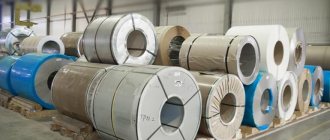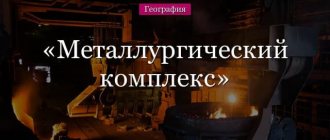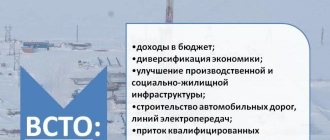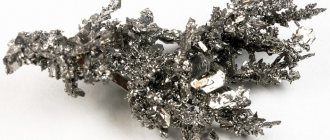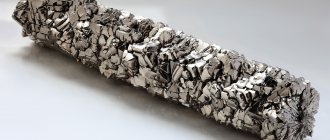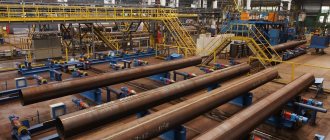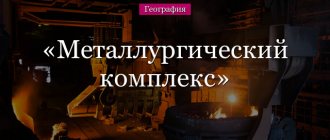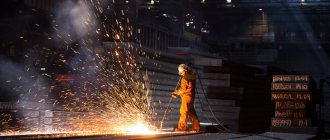Factors in the location of ferrous metallurgy are determined mainly by the geography of mineral deposits necessary for the metallurgical process. From the standpoint of economic feasibility, metallurgical plants appear in the vicinity of iron ore deposits. This is a general rule.
However, there are exceptions to this. The absence of coal basins and powerful power plants near iron ore deposits excludes the possibility of building a metallurgical plant in such an area. Ideal conditions are considered to be the concentration of all factors in one place: the presence of ore, coal and electricity.
The choice of area for the construction of a metallurgical plant plays an important role, because new cities grow around the new enterprise, infrastructure develops, and the economic activity of small businesses increases. Most metallurgical plants play a city-forming role in their locations.
The importance of metallurgy for economic development
Russia is one of the world leaders in steel production. The metallurgical industry of the Russian Federation constitutes a significant part of the country's gross domestic product. According to this indicator, it is second only to the oil and gas sector.
The export of metal products provides stable foreign exchange earnings to the Russian economy.
The metallurgical complex consists of ferrous and non-ferrous metallurgy. Products produced by metallurgical plants are used in a huge number of sectors of the economy. Ferrous metallurgy indirectly creates jobs in related industries.
Rolled metal is the basis of mechanical engineering and construction. In the production of many parts, housings, reinforcing elements and fasteners, steel is simply irreplaceable in terms of performance characteristics.
To understand the principles by which the location of new metallurgical plants is selected, you need to understand the features of steel production technology.
Tin industry in Russia
A distinctive feature of this industrial sector is the territorial dispersion of the stages of the technological process.
Tin reserves are located in:
- Yakutia;
- Primorsky Krai;
- Chukotka Autonomous Okrug;
- Khabarovsk Territory;
- Sherlovogorsk field;
- Irkutsk region;
- Omsukchan and Khingan fields.
Almost all Russian tin, more than 95%, is smelted at NOC OJSC.
Metallurgical processing is focused on areas of consumption and routes for concentrates.
Features of the metallurgical process
A metallurgical plant is an enterprise with a full metallurgical cycle, including all three stages of the metallurgical process: iron smelting, steel production, rolling.
There are two types of metallurgical plants:
- plant producing steel and rolled products;
- a plant where iron and steel are produced.
The technological process for the production of steel and rolled products is a complex sequence, the stages of which are as follows:
Mining of iron ore, coking coal and limestone;
- ore dressing at mining and processing plants;
- coal coking;
- smelting cast iron in blast furnaces;
- steel production in oxygen converters or open-hearth furnaces;
- rolling steel ingots on crimping mills;
- rolling of blooms and slabs on section rolling, sheet rolling and pipe rolling mills.
The production of rolled metal is impossible without the presence of powerful energy resources. This factor stimulates the development of the electric power industry and other related sectors of the economy. Russia's electric power potential ensures the production of steel and rolled metal at dozens of factories and mills.
The blast furnace process requires specific carbon-containing fuel. This need is met by coke production.
The factors for locating ferrous metallurgy enterprises are determined by its basis – raw materials.
- 1. Metallurgical complex of Russia. Ferrous metallurgy. Features of enterprise location
- 2. Non-ferrous metallurgy
LECTURE No. 5. Metallurgical complex of Russia
1. Metallurgical complex of Russia. Ferrous metallurgy. Features of enterprise location
The metallurgical complex includes ferrous
and
non-ferrous metallurgy , covering all stages of technological processes: from the extraction and enrichment of raw materials to the production of finished products in the form of ferrous and non-ferrous metals and their alloys.
The metallurgical complex
is an interdependent combination of the following technological processes:
1) extraction and preparation of raw materials for processing (extraction, enrichment, agglomeration, obtaining the necessary concentrates, etc.);
2) metallurgical processing - the main technological process with the production of cast iron, steel, rolled ferrous and non-ferrous metals, pipes, etc.;
3) production of alloys;
4) recycling of main production waste and obtaining various types of products from them.
The specific features of the metallurgical complex are the production scale, which is incomparable with other industries, and the complexity of the technological cycle.
To produce many types of products, 15–18 processing steps are required, starting with the extraction of ore and other types of raw materials. At the same time, processing enterprises have close ties with each other not only within Russia, but also across the Commonwealth countries. Ferrous metallurgy
The role and significance of ferrous metallurgy
determined primarily by the fact that it serves as the foundation for the development of mechanical engineering.
Ferrous metallurgy covers the entire process: from the extraction and preparation of raw materials, fuel, and auxiliary materials to the production of rolled products with products for further processing.
It includes: mining, enrichment and agglomeration of iron, manganese and chromite ores; production of cast iron, blast furnace ferroalloys, steel and rolled products; production of electroferroalloys; secondary processing of ferrous alloys; coking of coal; production of refractories; extraction of auxiliary materials (fluxing limestone, magnesite, etc.); production of metallurgical products for industrial purposes[45]. In this complex, the core is the metallurgical process itself (cast iron-steel-roll). The rest of the production is related and related.
In terms of concentration of ferrous metal production, Russia is ahead of many industrialized countries, including the United States. More than 3/4 of cast iron and 2/3 of steel, approximately 3/5 of rolled products are produced in our country by enterprises with an annual productivity of more than 3 million tons each.
At the eight largest enterprises - Magnitogorsk, Nizhny Tagil, Chelyabinsk and Orsko-Khalilovsky (Ural), Cherepovets (North), Novolipetsk (Central Chernozem region), West Siberian and Kuznetsk (Western Siberia) plants - 9/10 of all cast iron is produced, over 4/5 of steel (including all converter steel and more than 4/5 cast on continuous casters) and over 4/5 of rolled products. These enterprises process more than 9/10 of iron ore and 2/5 of secondary raw materials.
A highly developed production combination is also characteristic. Particularly great benefits come from combining metallurgical processing with coal coking. In Russia, over 95% of all coke is produced by metallurgical plants. Modern large enterprises of ferrous metallurgy, by the nature of internal technological connections, are metallurgical and energy chemical plants.
Combines
- the main type of ferrous metallurgy enterprises in most industrialized countries. In Russia, full-cycle enterprises produce approximately 9/10 of cast iron, steel and rolled products. In addition, there are factories producing cast iron and steel or steel and rolled products (including pipe and hardware plants), as well as separately cast iron, steel and rolled products.
All enterprises without iron smelting belong to the so-called pigment metallurgy. A special position in terms of technical and economic parameters is occupied by enterprises with electrometallurgical production of steel and ferroalloys. Finally, “small metallurgy” is highlighted (production of steel and rolled products at machine-building plants).
Ferrous metallurgy with a full technological cycle is an important regional-forming factor.
In addition to numerous industries arising from the disposal of various types of waste from iron smelting and coal coking, it attracts related industries. The most typical satellites of ferrous metallurgy are
1) thermal power generation, primarily installations that are part of metallurgical plants and can operate on by-product fuel (excess blast furnace gas, coke, coke breeze);
2) metal-intensive mechanical engineering (metallurgical and mining equipment, heavy machine tools, metal structures, locomotive, etc.).
The main iron ore resources are concentrated within the KMA (21.6 billion tons), where such deposits of world importance as Lebedinskoye, Stoilenskoye, Mikhailovskoye and Yakovlevskoye are located. Great iron ore resources of the Urals (almost 7.5 billion tons), within which the Kachkanar group of deposits (3.5 billion tons) especially stands out.
In third place is Eastern Siberia (5.3 billion tons) with the Korshunovskoye and Rudnogorskoye fields in the Angara-Ilimsk basin and the Abakan group of fields. Then come the Far East (4.5 billion tons), the Northern region (2.8 billion tons), where the Eno-Kovdorskoye, Kostamuksha and other deposits are known, and Western Siberia (1.8 billion tons).
The most significant resources of manganese ores are represented in Western Siberia (Usinsk deposit), and chromite ores in the Urals (Sarany deposit).
Ferrous metallurgy with a full technological cycle, depending on economic feasibility, gravitates towards sources of raw materials (Ural, central regions of the European part) and fuel bases (Kuzbass) or, finally, to points located between them (Cherepovets)[46].
Particle metallurgy focuses mainly on sources of secondary raw materials (waste from metallurgical production, waste from consumed rolled products, depreciation scrap) and on places of consumption of finished products, since the largest amount of scrap metal accumulates in areas of developed mechanical engineering[47]. Small metallurgy interacts even more closely with mechanical engineering.
Despite all the changes that have occurred in the location of production in connection with the development of new sources of raw materials and fuel in different regions of the country, the Urals continues to maintain its position as the largest metallurgical base in Russia. Second and third places are shared by the Center and Siberia with the Far East. The Northern region is in fourth place.
Ural
produces almost 1/2 of the country's cast iron, steel and rolled products. The black Ural metallurgy uses imported fuel (Kuznetsk and Karaganda coal), partially works on raw materials coming from Kazakhstan (Sokolovsko-Sarbai ore), as well as KMA. Strengthening the raw material base here is associated with the development of titanomagnetites (Kachkanarskoye deposit) and siderites (Bakalskoye deposit), which account for 3/4 of iron ore reserves. Titanomagnetites are already involved in development (Kachkanarsky GOK).
With the significant development of pigment metallurgy, which causes a noticeable (1.5 times) excess of steel production over pig iron production, the main role is played by enterprises with a full cycle. They are located mainly along the eastern slopes of the Ural Mountains. On the western slopes, pigment metallurgy is more represented.
The concentration of production reaches a high level here. The predominant part of ferrous metals is produced by giant enterprises (in Magnitogorsk, Nizhny Tagil, Chelyabinsk, Novotroitsk), which arose during the years of industrialization. At the same time, many small factories (albeit reconstructed) have survived in the Urals, producing more than 1/10 of cast iron and steel and more than 1/5 of all rolled products.
Noteworthy is the qualitative profile of the Ural metallurgy, which largely depends on the specification of raw materials.
A prominent position here is occupied by the production of ferroalloys by blast furnace (Chusovoy) and electrometallurgical (Serov, Chelyabinsk) methods, and pipe rolling (Pervouralsk, Kamensk-Uralsky, Chelyabinsk). In addition, the Urals are the only region in the country where natural alloy metals are smelted (Novotroitsk).
Center
being an old region of ferrous metallurgy, it developed relatively recently in two unrelated directions: on the one hand, in the smelting of cast iron and blast furnace ferroalloys (Tula), on the other, in the production of steel and rolled products mainly from metal scrap (Moscow, Elektrostal, Nizhny Novgorod, etc.). “Small metallurgy” has always reached large proportions here.
Currently, the Center is one of the main metallurgical bases of the country. It produces more than 2/5 of all iron ore in the country, and in terms of iron ore production it is on a par with Siberia and the Far East. The previously existing gap in the Center between the individual stages of the technological process has been eliminated as a result of the production of pig iron. The construction, subsequent reconstruction and expansion of full-cycle enterprises (Novolipetsk and Novotulsky plants) made it possible to sharply reduce the role of separate processing units for steel and cast iron and thereby create a combined production.
The level of combination in the ferrous metallurgy of the Center is still significantly lower than in the Urals. Full-cycle plants produce a little more than 1/2 of all cast iron and about 2/3 of steel and rolled products.
The ferrous metallurgy of the Center is completely dependent on imported fuel (Donetsk coal or coke). The raw material resources represented by the KMA deposits practically do not limit production. Scrap metal is of great importance.
Almost all iron ore is mined by open pit mining. Along with rich ores, ferruginous quartzites are mined in large quantities (Lebedinsky, Stoilensky and Mikhailovsky GOKs). The Yakovlevskoe rich ore deposit is being developed. KMA serves as a source of raw materials not only for the factories of the Center, it also provides it to a number of enterprises in the Urals, as well as in the North.
Within the KMA, the production of metallized pellets arose. On this basis, electrometallurgy is developing without blast furnace processing (Oskol plant). The production of cold-rolled strip was created (Oryol Steel Rolling Plant).
Siberia
(together with the Far East) as a metallurgical base is in the process of formation. It is somewhat inferior to the Center for the smelting of iron and steel, but superior to it in terms of rolled products. Modern production is represented here by two powerful enterprises with a full cycle - the Kuznetsk Metallurgical Plant and the West Siberian Plant (Novokuznetsk) - and several processing plants (Novosibirsk, Guryevsk, Krasnoyarsk, Petrovsk-Zabaikalsky, Komsomolsk-on-Amur), as well as a ferroalloy plant ( Novokuznetsk).
The raw material base is the iron ores of Gornaya Shoria, Khakassia and the Angara-Ilim basin (Korshunovsky GOK). Fuel base - Kuzbass.
Northern region
began to take shape as a metallurgical base in connection with the creation of the Cherepovets Metallurgical Plant, which has been operating as a full-cycle enterprise since 1960. The plant uses iron ore from the Kola Peninsula (Kovdorsky, Olenegorsky GOK), Karelia (Kostamuksha GOK) and coking coal from the Pechora basin.
Outside the metallurgical bases, there are relatively large metallurgical plants in the North Caucasus (Krasny Sulin, Taganrog) and in the Volga region (Volgograd). A new conversion plant also operates in the Far East (Komsomolsk-on-Amur).
2. Non-ferrous metallurgy
Non-ferrous metallurgy
includes mining, enrichment, metallurgical processing of non-ferrous, precious and rare metal ores, including the production of alloys, rolling of non-ferrous metals and processing of secondary raw materials, as well as diamond mining. Participating in the creation of structural materials of ever higher quality, it performs essential functions in the conditions of modern scientific and technological progress[48].
Due to the variety of raw materials used and the widespread use of non-ferrous metals in modern industry, non-ferrous metallurgy is characterized by a complex structure.
According to their physical properties and purpose, non-ferrous metals are conventionally divided into four groups: basic, which include heavy (copper, lead, zinc, tin, nickel), light (aluminum, magnesium, titanium, sodium, potassium, etc.), small (bismuth , cadmium, antimony, arsenic, cobalt, mercury); alloying (tungsten, molybdenum, tantalum, niobium, vanadium); noble (gold, silver and platinum with platinum group metals); rare and scattered (zirconium, gallium, indium, thallium, germanium, selenium, etc.).
Included in the non-ferrous metallurgy of Russia
includes copper, lead-zinc, nickel-cobalt, aluminum, titanium-magnesium, tungsten-molybdenum, hard alloys, rare metals and other industries, separated depending on the type of product, as well as gold processing. According to the stages of the technological process, it is divided into the extraction and enrichment of feedstock, metallurgical processing and processing of non-ferrous metals.
Non-ferrous metallurgy is characterized by the organization of closed technological schemes with multiple processing of intermediate products and disposal of various wastes. In the future, this trend will intensify. At the same time, the limits of production combination are expanding, which makes it possible to obtain additional products in addition to non-ferrous metals - sulfuric acid, mineral fertilizers, cement, etc.
Due to significant material consumption, non-ferrous metallurgy focuses mainly on raw material bases. At the same time, enrichment is directly “tied” to the places of extraction of non-ferrous and rare metal ores.
Non-ferrous metal ores have an extremely low content of useful components. Typical ores used for the production of copper, lead, zinc, nickel, and tin contain only a few percent and sometimes even fractions of a percent of the base metal.
Ores of non-ferrous and rare metals are multicomponent in composition. In this regard, the integrated use of raw materials is of great practical importance.
Consistent and deep metallurgical processing with repeated return to the head of the technological process of intermediate products and comprehensive waste disposal for the most complete extraction of useful components determine the widespread development of production combinations within non-ferrous metallurgy.
The efficiency of combination based on the complex processing of non-ferrous and rare metal ores is extremely high, taking into account that, firstly, most of the accompanying elements do not form independent deposits and can only be obtained in this way, and secondly, the raw material base of non-ferrous metallurgy often located within poorly developed areas and therefore require additional costs for industrial development.
The integrated use of raw materials and recycling of industrial waste connects non-ferrous metallurgy with other branches of heavy industry. On this basis, entire industrial complexes are being formed in certain regions of the country (North, Urals, Siberia, etc.).
Of particular interest is the combination of non-ferrous metallurgy and basic chemistry, which appears in particular when using sulfur dioxide gases in the production of zinc and copper. Even more complex territorial combinations of different industries arise during the complex processing of nephelines, when aluminum, soda, potash and cement are extracted from the same raw materials as finished products and, thus, not only the chemical industry, but also the and the building materials industry.
In addition to raw materials, the fuel and energy factor plays a significant role in the deployment of non-ferrous metallurgy. From the point of view of the requirements for fuel and energy, it includes fuel-intensive and electricity-intensive industries.
Raw materials and fuel and energy factors have different effects on the location of enterprises in different branches of non-ferrous metallurgy. Moreover, in the same industry their role is differentiated depending on the stage of the technological process or the adopted scheme for the production of non-ferrous and rare metals. Therefore, non-ferrous metallurgy has a greater number of production location options compared to ferrous metallurgy.
Copper industry
due to the relatively low content of concentrates, it is confined (excluding ferrous metal refining) to areas with raw material resources.
The main type of ore currently used in Russia for copper production is copper pyrites, which are represented mainly in the Urals (Krasnouralskoye, Revdinskoye, Blavinskoye, Sibaiskoye, Gaiskoye and other deposits). An important reserve is cuprous sandstones concentrated in Eastern Siberia (Udokan deposit). Copper-molybdenum ores are also found.
Copper-nickel and polymetallic ores are used as additional raw materials.
In the Urals, enterprises for the production of blister copper and its refining are separated from each other. The former include the Krasnouralsk, Kirovograd, Sredneuralsk, Karabash and Mednogorsk copper smelters, the latter - the Kyshtym and Verkhnepyshminsk copper-electrolyte plants.
Lead-zinc industry
is characterized by more complex structural and territorial features compared to the copper industry.
In general, it is confined to the areas of distribution of polymetallic ores - the North Caucasus (Sadon), Kuzbass (Solair), Transbaikalia (Nerchinsky deposits) and Far Eastern Primorye (Dalnegorsk).
However, due to the fact that lead and zinc concentrates have a fairly high content of useful components, and therefore transportability (as opposed to copper concentrates), enrichment and metallurgical processing are often separated from each other. Thus, in the Urals, the specificity of the raw material base of which is the presence of copper-zinc ores, for the production of zinc (Chelyabinsk) not only local concentrates are used, but also those coming from other regions of the country. Similar cases occur in lead smelting.
A characteristic feature of the lead-zinc industry is the territorial separation of beneficiation and metallurgical processing. Another important feature of the industry is that, despite the complex composition of the raw materials, not everywhere lead and zinc are obtained in pure form at the same time. Based on the degree of completeness of the technological process, the following areas are distinguished:
1) for the production of lead and zinc concentrates without metallurgical processing - Transbaikalia;
2) for the production of metal lead and zinc concentrates - Far Eastern Primorye (Dalnegorsk);
3) for the production of metallic zinc and lead concentrates - Kuzbass (Belovo);
4) for the joint processing of lead and zinc - North Caucasus (Vladikavkaz);
5) for the production of metallic zinc from imported concentrates - Ural (Chelyabinsk).
Nickel-cobalt industry
is most closely related to the sources of raw materials, which is due to the low content of intermediate products (matte and matte) obtained during the processing of the original ores.
In Russia, two types of ores are exploited: sulfide (copper-nickel), which are known on the Kola Peninsula (Nickel) and in the lower reaches of the Yenisei (Norilsk), and oxidized ores in the Urals (Verkhniy Ufaley, Orsk, Rezh). The Norilsk region is especially rich in sulfide ores. New sources of raw materials have been identified here (Talnakh and Oktyabrskoye deposits), which makes it possible to further expand the metallurgical processing of nickel.
The Norilsk region is the largest center for the integrated use of copper-nickel ores. At the plant operating here, which combines all stages of the technological process - from raw materials to finished products, nickel, cobalt, platinum (together with platinum group metals), copper and some rare metals are produced. By recycling waste, sulfuric acid, soda and other chemical products are obtained.
The Kola Peninsula, where several enterprises of the nickel-cobalt industry are located, is also characterized by complex processing of feedstock. Mining and enrichment of copper-nickel ores and production of high-grade matte are carried out in Nikel. The Severonickel plant (Monchegorsk) is completing its metallurgical processing. Waste recycling allows you to additionally obtain sulfuric acid, mineral wool and thermal insulation boards.
Tin industry
in contrast to nickel-cobalt, it is represented by geographically separated stages of the technological process. Metallurgical processing is not associated with sources of raw materials.
It is focused on areas of consumption of finished products or located along the route of concentrates (Novosibirsk). This is due to the fact that, on the one hand, the extraction of raw materials is often dispersed over small deposits, and on the other hand, enrichment products are highly transportable.
The main tin resources are located in Eastern Siberia and the Far East. Sherlovogorsky, Khrustalnensky, Solnechny, Esse-Khaisky and other mining and processing plants operate here. The construction of the first stage of the Deputatsky Mining and Processing Plant (Yakutia) is being completed.
The geography of production of light non-ferrous metals, primarily aluminum, is characterized by special features.
Aluminum industry
uses raw materials of higher quality than other branches of non-ferrous metallurgy. Raw materials are represented by bauxite, which is mined in the North-West (Boksitogorsk) and the Urals (Severouralsk), as well as nephelines - in the Northern region, on the Kola Peninsula (Kirovsk), in Eastern Siberia (Goryachegorsk). A new bauxite mining center is being formed in the Northern region (North Onega deposit). In terms of composition, bauxites are simple, and nephelines are complex raw materials.
The technological process in the aluminum industry consists of two main stages: the production of alumina and the production of aluminum metal. Geographically, these stages can be located together, as, for example, in the North-West or the Urals. However, for the most part, even within the same economic region, they are separated, because they are subject to the influence of different location factors. The production of alumina, being material-intensive, gravitates towards sources of raw materials, and the production of aluminum metal, being energy-intensive, is focused on sources of mass and cheap electrical energy.
Regions where limestone and cheap fuel are found along with aluminum raw materials should be considered optimal for alumina production. These include, in particular, Achinsk-Krasnoyarsk in Eastern Siberia and North Ural-Krasnoturinsky in the Urals.
Alumina production centers are located in the North-West (Boxitogorsk - Tikhvin bauxites, Volkhov and Pekalevo - Khibiny nephelines), in the Urals (Krasnoturinsk and Kamensk-Uralsky - North Ural bauxites) and in Eastern Siberia (Achinsk - Kiya-Shaltyr nephelines). Consequently, alumina is obtained not only from the sources of raw materials, but also away from them, but in the presence of limestone and cheap fuel, as well as in an advantageous transport and geographical location.
The Urals are in first place in alumina production (more than 2/5 of the total output), followed by Eastern Siberia (over 1/3) and the North-West (more than 1/5). But domestic production provides only half of the existing needs. The remaining amount of alumina is exported from neighboring countries (Kazakhstan, Azerbaijan and Ukraine), as well as from Yugoslavia, Hungary, Greece, Venezuela and other countries.
In Russia, all centers for the production of metallic aluminum (with the exception of the Urals) are more or less distant from raw materials and are located near hydroelectric power stations (Volgograd, Volkhov, Kandalaksha, Nadvoitsy, Bratsk, Shelekhov, Krasnoyarsk, Sayanogorsk) and partly where large power plants operate on cheap fuel (Novokuznetsk).
Joint production of alumina and aluminum is carried out in the North-Western region (Volkhov) and in the Urals (Krasnoturinsk and Kamensk-Uralsky).
The most powerful enterprises for alumina operate in Achinsk, Krasnoturinsk, Kamensk-Uralsky and Pikalyov, for aluminum - in Bratsk, Krasnoyarsk, Sayanogorsk and Irkutsk (Shelekhov). Thus, Eastern Siberia is sharply ahead in the production of aluminum metal (almost 4/5 of the total production volume in the country).
The final stage of the technological process in non-ferrous metallurgy - processing of metals and their alloys - is close to areas of consumption and is usually located in large industrial centers. Consumption areas also attract the processing of secondary raw materials - an important additional resource in increasing the production of non-ferrous metals, which makes it possible to obtain finished products at much lower costs.
Gold mining industry –
one of the oldest in Russia. In 1993, 132.1 tons of gold were produced, which gives our country fifth place in the world after South Africa, the USA, Canada and Australia.
Currently, the share of Russian gold in world production is about 8%.
In terms of proven reserves, which are estimated at no less than 5 thousand tons, Russia is significantly inferior only to South Africa, but surpasses Australia and Canada and is on the same level as the United States. Domestic deposits are represented by alluvial, primary (ore) and complex (gold in combination with copper, base metals, etc.). The main reserves are concentrated in primary deposits, followed by complex and, finally, alluvial deposits.
Meanwhile, alluvial deposits have always been developed most intensively: their development required less money and time compared to primary deposits. Now they account for about 3/4 of total production.
The bulk of domestic gold is mined in the Far East (2/3 of the total) and in Eastern Siberia (over 1/4). In the Far East, 2/3 of all production is concentrated in the mines of Yakutia (30.7 tons) and the Magadan region (28.2 tons). In Eastern Siberia, 2/3 of production is also concentrated in the Irkutsk region (11.7 tons) and Krasnoyarsk Territory (10.8 tons).
The rest of the gold comes from the Urals (5%), where mines arose much earlier than in other regions of Russia, Western Siberia and the north of the European part.
Table of contents
Raw material base
Domestic metallurgy is developing thanks to the wealth of minerals that fill the bowels of the state.
Numerous deposits of coking coal fully satisfy the needs of metallurgists. Most Ural plants operate on coal supplied from the Kuznetsk coal basin (Kuzbass).
In terms of iron ore reserves, the Russian Federation is now in first place in the world. Its territory contains about 19% of the world's reserves of this mineral. Large deposits of iron ore are called an iron ore basin. The largest examples of them in the post-Soviet space are:
- Krivoy Rog iron ore basin;
- iron ore basin of the southern Urals;
- Kursk magnetic anomaly.
Experts develop iron ore deposits using open (quarry) and underground (mine) methods.
The feasibility of developing deposits of coal or ferruginous quartzite is determined by the depth of the deposits, transport accessibility of the deposit, as well as technological parameters.
Having considered the factors (not only raw materials) influencing the choice of location for metallurgical plants.
Aluminum industry in Russia
Deposits of bauxite, from which aluminum is obtained, are located in:
- Ural;
- North;
- North-West;
- in Eastern Siberia.
The bulk of the aluminum industry is located in:
- Central Federal District;
- Northwestern Federal District;
- Southern Federal District;
- Volga Federal District west of the Urals.
| Locality | Raw materials used |
| Boksitogorsk | Tikhvin bauxite |
| Volkhv, Pikalevo | Khaba nephelines |
| Kamensk-Uralsk, Krasnoturinsk | North Ural bauxites |
Criteria for choosing the location of metallurgical enterprises
The greatest economic effect is achieved when enterprises and interrelated industries are concentrated in one territory. This gives metallurgical plants significant savings on transportation costs.
It also greatly simplifies the organization of production management:
- Metallurgical plants, due to their technology, require large volumes of water resources. This makes it mandatory for them to be located near bodies of water.
- The environmental factor is also important. Metallurgical plants cannot be built near environmental protection zones. Their design must take into account the wind rose of each specific area.
- Electrometallurgical plants require large amounts of electricity and scrap metal to operate. Such enterprises are usually built near powerful hydroelectric power stations.
Industrial zones with metallurgical plants should be located at a reasonable distance from residential areas. Under the influence of these factors, design institutes are developing new metallurgical enterprises that comply with all environmental protection standards.
Among the many factors for the location of ferrous metallurgy, a special place is occupied by its proximity or distance from large river and sea ports. Export deliveries are most feasible when products are shipped by sea, which is the cheapest. Proximity to the river system is one of the main requirements for the construction site of a metallurgical plant.
Ferrous metallurgy
Metallurgy development centers in Russia
Most Russian metallurgical enterprises are located in the Urals. This region accounts for up to half of the total volume of steel produced. The main industry giants are located in Magnitogorsk, Chelyabinsk and Nizhny Tagil.
In the European part of Russia, large plants are located in Lipetsk, Cherepovets and Stary Oskol. In the latter, by the way, there is the only electrometallurgical plant in Russia.
In the West Siberian region, metallurgical production is represented by two large plants in Novokuznetsk. The factors for the location of metallurgy in Siberia are determined by the presence of cheap Kuzbass coal in this territory.
The geography of the location of metallurgical enterprises is quite extensive. The general rule for the three named centers of metallurgy is the attraction to sources of raw materials and fuel.
Metallurgy of non-ferrous metals has its own characteristics.
How does this industry differ from ferrous metallurgy in terms of its location factors?
Aluminum production
The aluminum industry occupies one of the leading and unique positions in non-ferrous metallurgy. This fact is explained by the fact that higher quality raw materials (bauxite, nepheline) are used for metal production. The central territories where bauxite production is carried out are considered to be Boksitogorsk, Severouralsk and the Severo-Onezhskoye deposit.
Nepheline deposits are located in Kirovsk on the Kola Peninsula and in Goryachegorsk, which is located in Eastern Siberia. The difference between the minerals is that nephelines have a more complex composition. Main stages of the aluminum industry:
- alumina production;
- production of metal aluminum.
Such activities can occur both in one area and in different territories. Enterprises producing alumina try to locate as close as possible to the deposits, since this production is considered more material-intensive.
Aluminum plants are located closer to sources of mass and cheap electricity. Russia is second only to the People's Republic of China in the production of this metal. Comparative table of aluminum production in thousands of tons by countries for 2012 and 2016.
| Place | A country | 2012 | 2016 |
| 1 | China | 21500 | 31000 |
| 2 | Russia | 3950 | 3580 |
| 3 | Canada | 2900 | 3250 |
| 4 | India | 1700 | 2750 |
| 5 | UAE | 1800 | 2400 |
Areas where limestone and cheap fuel are found along with aluminum raw materials are considered optimal for the production of alumina. Such areas include Achinsk-Krasnoyarsk in Siberia and Severouralsko-Krasnoturinsky in the Urals. Enterprises for processing metals and alloys are located closer to consumers and are usually located in large industrial centers.
Features of non-ferrous metals production
A distinctive feature of non-ferrous metal smelting plants is the high level of environmental pollution from their activities and the high energy intensity of the technological process.
Non-ferrous metals are distinguished by the diversity of their deposits. The geography of non-ferrous metal deposits is very extensive. “Give examples,” the majority of the population will say. These are mountains, rivers, and large ore deposits on the ground and underground. Gold and rare earth metals “live” in the sands. People can provide examples of some copper mines in the Urals, where copper is extracted from groundwater.
The metallurgical process for the production of non-ferrous metals is similar to the same process in ferrous metallurgy, although it has its own characteristics. The technological chain for the production of non-ferrous metals is as follows:
- ore mining and beneficiation;
- smelting in high temperature furnaces;
- pressure treatment.
Ferrous metallurgy
Ferrous metallurgy is based on the processing of iron, namely the ores in which it is contained. Most iron ores are natural oxides. That is why the first stage of production is the separation of iron from the oxide. Large blast furnaces are used for this. This method of producing cast iron is carried out at temperatures above 1000 degrees.
Ferrous metallurgy
In this case, the properties of the resulting raw materials directly depend on the temperature of the blast furnace and the melting time. With further processing of cast iron, steel or foundry cast iron is obtained, with the help of which blanks and products are cast.
To produce steel, iron and carbon are used, the addition of which gives the resulting alloy the desired properties. Various alloying components can also be used to achieve certain characteristics of the steel.
There are several methods for producing steel, which are based on smelting the metal in a liquid state. The following should be highlighted: open hearth, oxygen-converter and electric melting.
Each type of steel is called a grade, which indicates its composition and properties. To change the properties of steel, an alloying method is used, that is, adding additional components to the alloy. The elements most often used for such purposes are chromium, manganese, boron, nickel, tungsten, titanium cobalt, copper and aluminum. Typically, such components are added to molten steel.
But there is another method, which consists in pressing fine-grained powder of the components and then baking at high temperatures.
Criteria for choosing the location of non-ferrous metallurgy facilities
The geological factor is the main criterion influencing the location of plants for the production of non-ferrous metals. Due to the low proportion of useful components in non-ferrous metal ores, their transportation is not economically feasible.
This requires the location of factories in this industry in mining areas. Nickel production, for example, is strictly tied to the place of its extraction.
Such factors lead to the fact that production is located in unfavorable climatic conditions - in the Arctic Circle (Norilsk).
The development of non-ferrous metal deposits is often associated with a number of difficulties. Access to useful minerals is often blocked by a shield of waste rock and must be blasted. Such development requires the use of a large amount of equipment: excavators, conveyors, electric locomotives.
Problems and prospects for the development of metallurgy in Russia
A common problem of the Russian metallurgical complex is the need for modernization and technical re-equipment.
Domestic metallurgical enterprises are faced with the task of reducing the energy intensity of their production. The rapid growth of metallurgy in China requires Russian manufacturers to take effective measures to reduce costs.
Reducing costs while maintaining the quality of products is the only way to be competitive manufacturers in the global steel parts market.
Metallurgy in the Far East will develop thanks to iron ore deposits in the Aldan province and the discovery of coking coal deposits in Yakutia. The construction of full-cycle metallurgical enterprises in the Far East is due to the need to reduce the cost of metal for the local machine-building plants.
Railroad deliveries significantly increase the cost of rolled steel. This factor plays a negative role in the competitiveness of metal-intensive enterprises in the Far East.
Metallurgy of the Far East and Siberia
This territory accounts for 13% of ferrous metal production. Centers:
Novokuznetsk – Novokuznetsk Metallurgical Plant – produces railway rails. Until 2011, it bore the name KMK and supplied products not only throughout Russia, but also abroad. OJSC West Siberian Metallurgical Plant is located 20 km from the city. It ranks 5th in size among Russian metallurgical plants. Issues:
- wire;
- Common consumption goods;
- coke, rolled, metallurgical products.
Iron ore comes from:
- Khakassia,
- Mountain Shoria;
- Angara-Ilimsk basin.
Pipe metallurgy enterprises:
- Petrovsky iron and cast iron plant;
- JSC Amurstal – rolled steel;
- Krasnoyarsk Metallurgical Plant.
